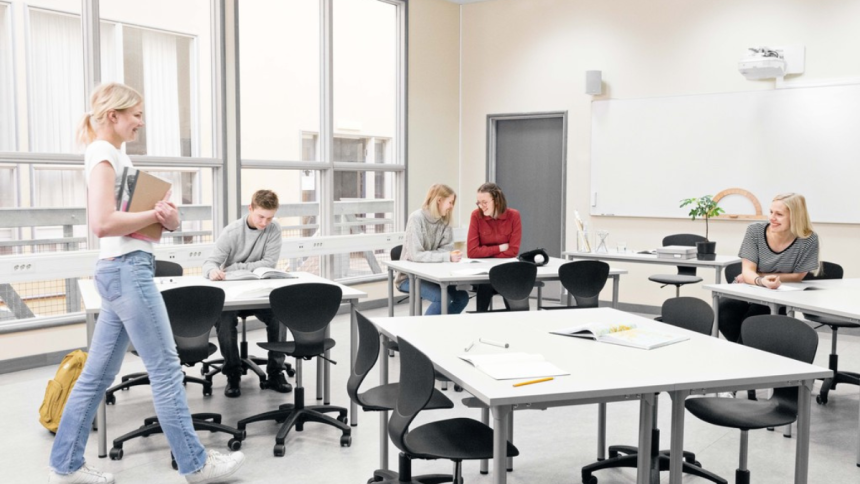Designing a classroom that truly supports student focus and engagement depends on more than just walls and desks. What if every aspect of the learning space could enhance attention, well-being, and active learning? When layout, furniture, lighting, acoustics, and air quality work together, students can stay engaged longer and feel more connected to their learning.
Physical comfort and movement
Ergonomics plays a critical role in focus, and solutions from a Top School Furniture Company can make a measurable difference. Adjustable desks and chairs tailored to students’ body dimensions help maintain proper posture, reducing strain and physical discomfort. Environments that include sit‑stand options or wobble stools encourage periodic movement, which improves blood flow and heightens alertness. Flexible seating can increase student mobility, with some students taking up to 2,000 additional steps per day in such environments.
Furniture configuration and collaboration
Traditional row‑and‑column seatings support individualized attention but may suppress student interaction. Clusters and U‑shaped arrangements foster peer talk and collaboration, boosting on‑task behaviors. Research shows that students sitting closer share similar engagement levels, and physiological synchrony may increase focus when seated in groups. Combining different seating patterns in one classroom supports multiple modes of learning.
Natural light, color, and air quality
Bright natural light enhances mood and cognitive performance. Proper daylighting improves behavior and academic results. Balanced color palettes, mixing warm and cool tones, prevent visual fatigue and support longer concentration. Crucially, clean air free of excessive CO₂ and volatile organic compounds supports clear thinking; high pollutant levels are linked with cognitive impairments.
Acoustics and sensory environment
Too much noise disrupts learning. Soft surfaces like cork, carpets, and acoustic tiles reduce reverberation, helping students process spoken language more easily. Quiet zones or sound‑dampened areas prevent overstimulation and maintain focus. Additionally, flexible spaces with minimal clutter reduce sensory overload and maintain calmness.
Innovative design and technology
Versatile furniture systems like benches, modular seating, and multi-use tables support both individual tasks and group projects. Products that incorporate power outlets and USB ports embed functionality into learning spaces. A desk-bench setup that transforms quickly helps students shift naturally between focus and collaboration.
Enhancing Learning Through Expert Space Planning
Class design services that consider ergonomic comfort, flexible seating, daylighting, air quality, and acoustics help schools create environments that support full engagement. Key offerings include ergonomic checks, flexible seating, and layouts supporting visibility and acoustic comfort throughout. These services improve traffic flow, storage, and multipurpose furniture use, creating efficient, adaptable classrooms. Aligning design with learning goals fosters inclusive, responsive, and future-ready environments that support student success.
Holistic benefits of optimized classroom environments
An evidence‑based design boosts multiple aspects of learning:
- Physical well‑being through movement‑friendly setups and ergonomic support
- Emotional comfort via clean air, appropriate lighting, and soothing colors
- Cognitive performance through reduced distractions, improved air quality, and designs that foster neural readiness
- Social learning through collaborative zones and group‑friendly seating
- Behavioral benefits such as reduced off‑task activity, enhanced participation, and peer awareness.
A well‑designed classroom blends the physical, social, and cognitive dimensions of learning. Thoughtful furniture choices and flexible layouts empower students to shift effortlessly between concentration and collaboration. Balanced lighting, controlled noise, and fresh air support health and mental acuity. Working with a Top School Furniture Company ensures that adaptive technology and ergonomic planning are integrated seamlessly, elevating the entire experience. By embracing a holistic approach, schools and institutions can cultivate spaces that nurture engagement, boost well‑being, and spark academic success. Paying attention to these details makes every square foot contribute purposefully to learning.
Lynn Martelli is an editor at Readability. She received her MFA in Creative Writing from Antioch University and has worked as an editor for over 10 years. Lynn has edited a wide variety of books, including fiction, non-fiction, memoirs, and more. In her free time, Lynn enjoys reading, writing, and spending time with her family and friends.















